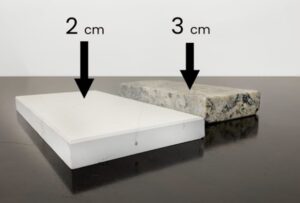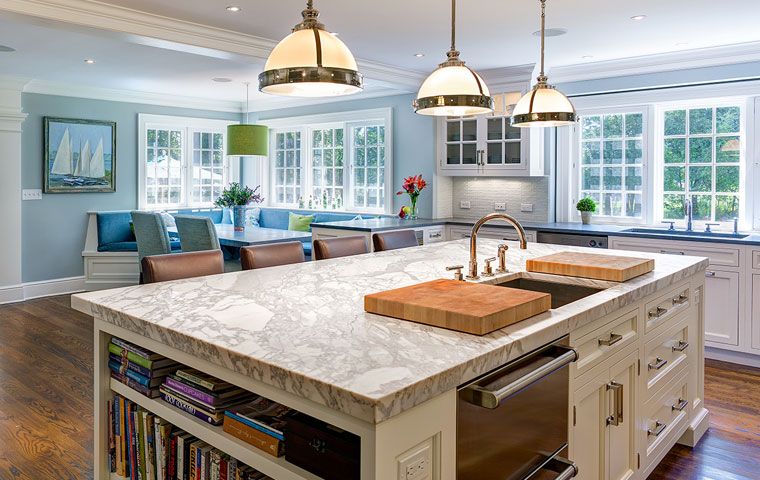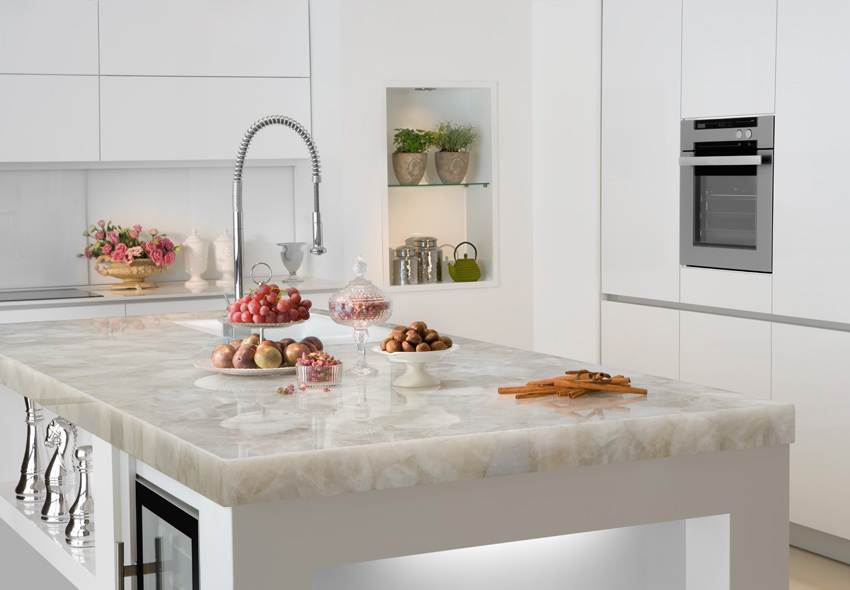Choosing the right slab thickness is one of the first—and most important—decisions you’ll make when planning a quartz countertop. The thickness you select affects everything from strength and installation time to edge style and project cost. In this detailed guide, you’ll learn the standard quartz thickness options, why each size matters, and how to decide which one best suits your kitchen, bath, or commercial space.
Why Countertop Thickness Matters
A quartz countertop has to do more than look good. It must:
- Support daily wear from hot pots, sharp knives, and heavy appliances
- Sit level on base cabinets without sagging or cracking
- Match the design style of the surrounding cabinetry, backsplashes, and flooring
Because thickness influences all three factors, understanding industry norms helps you make an informed decision instead of relying on guesswork or trends.
Industry Standards for Quartz Countertop Thickness
2 cm (¾ in.) Slabs
- Common in Europe and growing in popularity in North America
- Lightweight, which simplifies transport and allows installers to handle large panels with fewer crew members
- Usually mounted on plywood or MDF substrate for added stability
- Ideal for vertical applications such as full-height backsplashes, shower walls, and fireplace surrounds, where weight matters more than impact strength
3 cm (1¼ in.) Slabs
- North American default thickness for kitchen and bath counters
- Naturally strong enough to span standard cabinet boxes without extra support
- Provides a substantial edge profile, giving luxury appeal in showrooms and model homes
- Adds less complexity during installation because no underlayment is required in most layouts
Custom Thickness Options
- 1½ in. to 2 in.+ stacked edges created by laminating two 3 cm pieces or building mitered waterfalls
- Thin 1 cm panels for RVs, tiny homes, or furniture insets where every pound counts
- Custom solutions often raise fabrication costs but deliver statement-making visuals
What Is the Most Recommended Thickness of a Quartz Countertop?
For a typical residential kitchen or bathroom, 3 cm (1¼ in) quartz is the most widely recommended thickness. It combines dependable rigidity with straightforward installation and a timeless look. Homeowners renovating existing spaces often pick 3 cm to avoid extra carpentry or hidden plywood that thinner slabs require.
Benefits of Choosing the Standard 3 cm Quartz Thickness
Structural Strength and Durability
- Resists flexing across 24- to 36-inch cabinet spans
- Handles larger overhangs (10–12 in.) with minimal steel reinforcement
- Better absorbs daily impacts from cast-iron cookware or dropped utensils
Ease of Installation and Fabrication
- No separate sub-deck means fewer seams and faster installs
- Installers can polish a variety of edge profiles—beveled, ogee, bullnose—without visible lamination lines
- Reduced risk of cracking while cutting cooktop or sink openings
Design Versatility and Edge Profiles
- Thicker edge delivers a high-end, furniture-style finish that pairs well with shaker, slab, or inset cabinets
- Works seamlessly with popular design trends such as waterfall islands or full-height pantry counters
- Uniform thickness simplifies matching seams in large islands or L-shapes
Cost Efficiency Over Time
- Up-front material cost is higher than 2 cm, but installation labor is lower because no reinforcement deck is needed
- Long-term durability can mean fewer repairs and a better resale story for future buyers
Potential Drawbacks of Thinner Quartz Counter Surfaces (2 cm or Less)
- Additional Substrate
Each run must be glued to a plywood or MDF base, adding labor, adhesive, and time. - Limited Overhang
Any breakfast bar extension over 6–8 inches needs hidden steel supports to prevent deflection. - More Vulnerable Edges
Pencil or eased edges on 2 cm quartz can chip if cookware strikes the corner. - Fewer Edge Styles
Decorative treatments such as ogee or Dupont require lamination, which shows a faint seam line.
How to Decide on the Right Thickness for Your Project
| Decision Factor | 3 cm Quartz | 2 cm Quartz |
| Cabinet Strength | Works with standard framed or frameless cabinetry without extra bracing | Requires substrate; pay attention to span width |
| Project Budget | Higher material price, lower install complexity | Lower material price, higher labor cost |
| Design Vision | Bold, substantial edges; easier waterfalls | Sleeker, minimalist look when the substrate is concealed |
| Appliance Cut-outs | More forgiving during fabrication | Greater chance of breakage in narrow sections |
| Weight Limitations | Heavier—consider floor load in older homes | Light enough for floating vanities or boats |
Installation Tips and Best Practices
- Verify Cabinet Level
Use a laser line to check every base cabinet run. A quartz slab, especially in 3 cm, is less flexible than laminate and will crack if forced to bridge a dip. - Plan Overhang Reinforcement Early
For breakfast bars longer than 12 in. or thin (2 cm) slabs, outline steel L-brackets or concealed corbels before setting cabinets. - Minimize Seams
Ask your fabricator for digital slab layouts. Joining two pieces over a dishwasher opening weakens the countertop. - Use High-Quality Adhesives
Color-matched epoxy keeps joints tight and less visible, maintaining a continuous stone pattern.
Frequently Asked Questions
Is 2 cm quartz strong enough for a kitchen island?
Yes, with proper plywood backing and hidden steel supports at any overhang, 2 cm quartz can perform well. However, you’ll trade a slimmer profile for extra fabrication steps.
Does thicker quartz resist heat better?
Thickness alone doesn’t improve heat tolerance—quartz still contains resins that may discolor above 150 °C (302 °F). Always use trivets or hot pads.
Can I stack two 2 cm slabs instead of buying a 3 cm slab?
Technically, yes, but you’ll pay for double polishing and lamination. A single 3 cm piece usually costs less than two thinner layers once labor is added.
Will thicker quartz raise my countertop height?
Standard cabinet-plus-counter height is 36 in. with a 1¼-in. surface. If you switch from laminate (½ in) to 3 cm quartz, your tops rise by about ¾ in—often unnoticeable, but adjust outlet heights if needed.
Final Thoughts: Choosing the Perfect Quartz Countertop Thickness
Selecting the right thickness is a balancing act between style, strength, and cost. For most home kitchens and baths, 3 cm quartz remains the gold standard thanks to its structural integrity, installer-friendly nature, and timeless look. Thinner 2 cm slabs shine in vertical cladding, lightweight furniture, or projects where budget and transport outweigh heavy-duty performance.
When in doubt, ask your fabricator to show full-size samples on site. Seeing the slab edge against your cabinet doors, sink, and hardware lets you confirm the visual proportions before you commit. With careful planning, you’ll enjoy a quartz surface that looks polished, lasts for decades, and meets every practical demand of daily life


